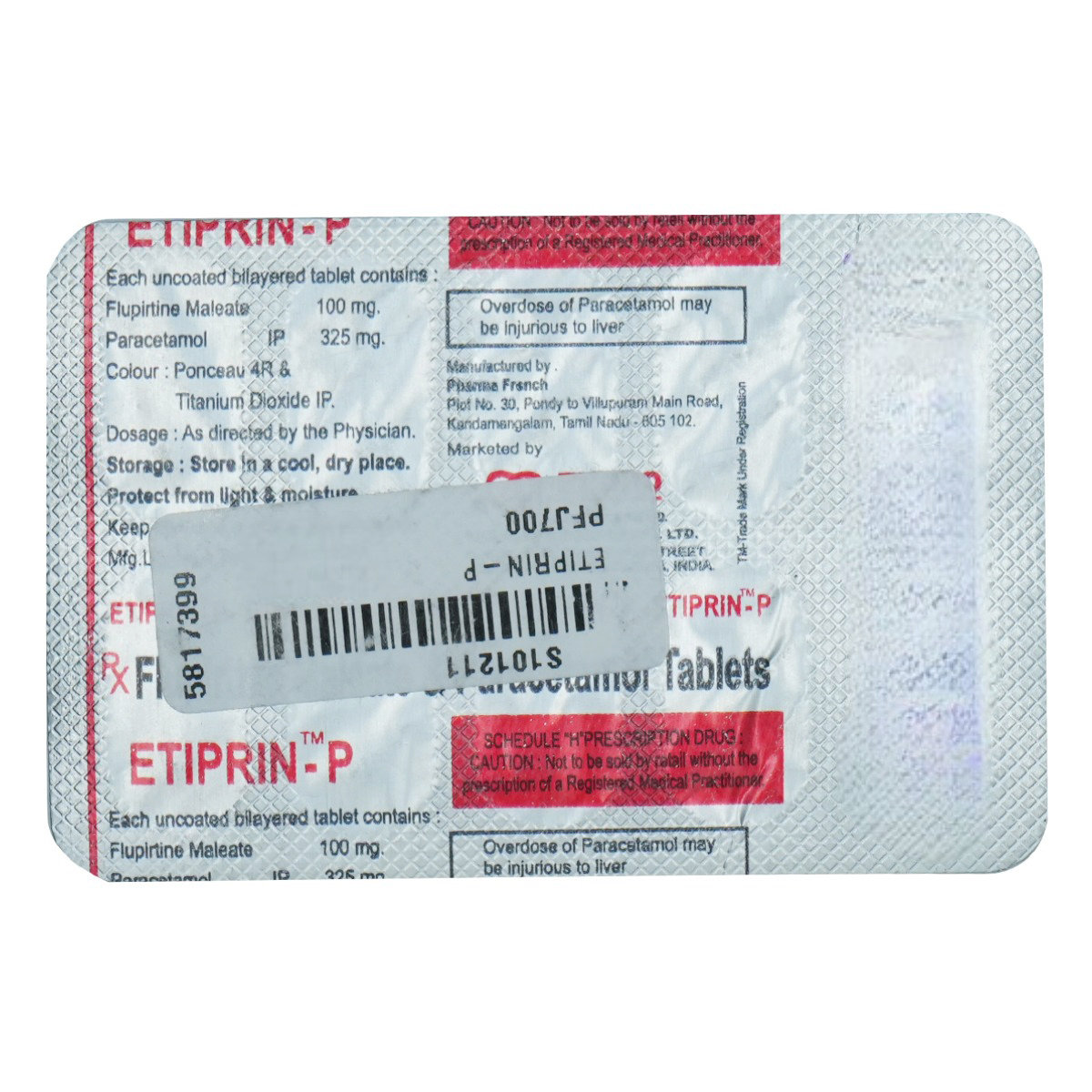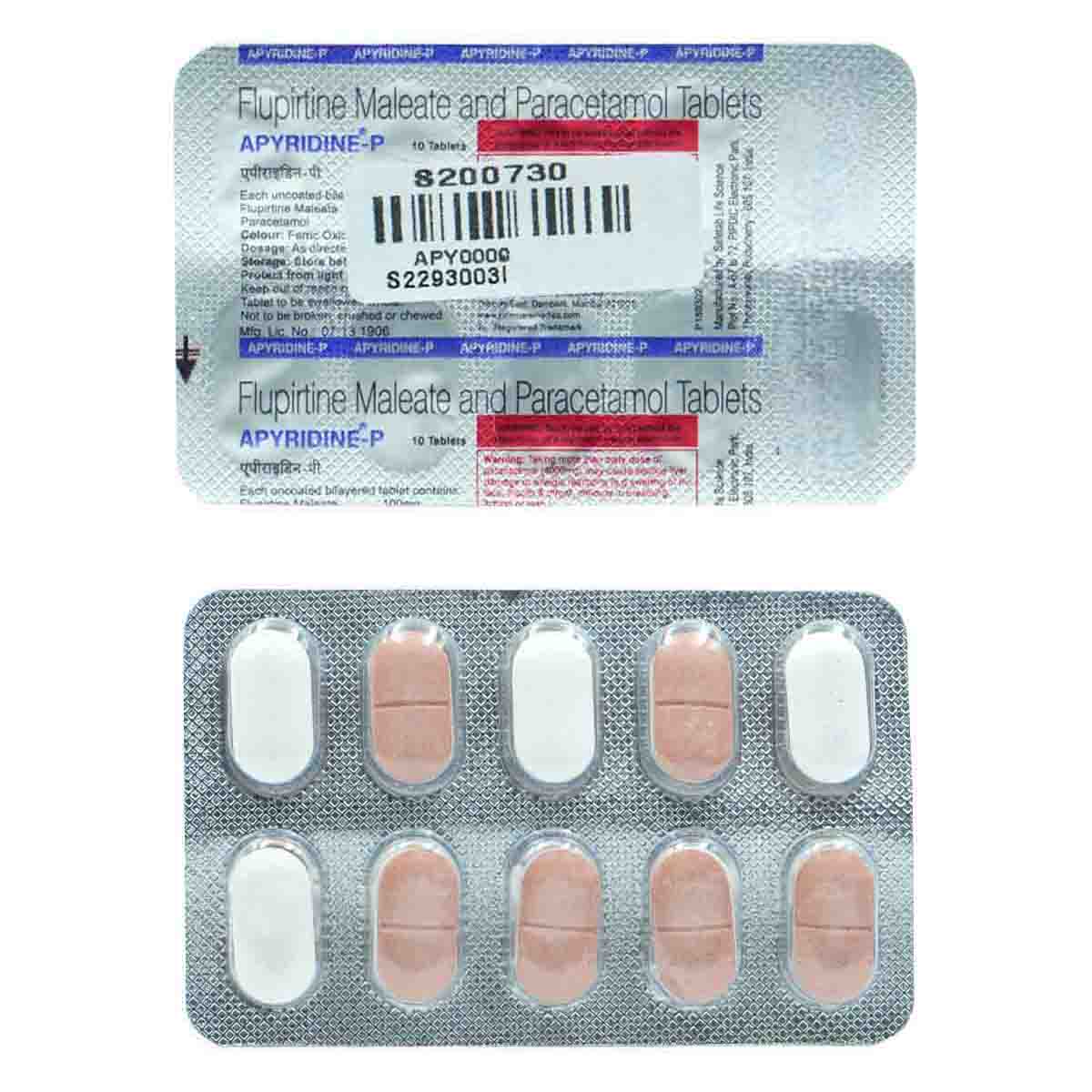Flupirtine+paracetamol
About Flupirtine+paracetamol
Flupirtine+paracetamol is a combination medication that belongs to the analgesic medication class. It is widely used in the treatment of acute and chronic pain, fever, headache, joint pains, dysmenorrhea (period pain), postoperative pain, toothache after dental extraction, and myalgia (muscle pain). Pain is a widely used term used to describe an unpleasant feeling or discomfort. It ranges from mild to severe. The severity of the pain depends on the underlying condition. Inflammation is the immune system's natural response to injury or infection.
Flupirtine+paracetamol contains flupirtine and paracetamol. Flupirtine is an analgesic (non-opioid analgesic) which works by blocking the transmission of pain signals to the brain to lower pain perception. Paracetamol is an analgesic (pain reliever) and an antipyretic (fever reducer), which works by blocking the release of certain chemical messengers that cause fever and pain. Thus Flupirtine+paracetamol alleviates pain and other associate conditions.
Use Flupirtine+paracetamol as directed by the physician only. The dose and duration of the medication depend on your condition and its severity. The common side effects of Flupirtine+paracetamol include nausea, vomiting, wind, abdominal discomfort, diarrhoea, constipation, heartburn, drowsiness, dizziness, headache, and depression. Most of these side effects of Flupirtine+paracetamol are temporary, do not require medical attention, and gradually resolve over time. However, if the side effects are persistent, reach out to your doctor.
Before taking Flupirtine+paracetamol, inform your doctor if you are allergic to flupirtine, paracetamol, or other ingredients. Besides, inform your doctor if you are pregnant, breastfeeding, or have any pre-existing conditions such as liver diseases such as hepatic encephalopathy (loss of brain function due to liver damage), chronic alcoholism, or cholestasis (reduced bile flow), renal impairment, myasthenia gravis (chronic neuromuscular disease), or heart diseases. If Flupirtine+paracetamol is given in patients with liver diseases, liver function should be monitored closely. Flupirtine+paracetamol causes drowsiness and dizziness, so drive only if you are alert. Flupirtine+paracetamol is not recommended for children younger than six years old.
Uses of Flupirtine+paracetamol
Medicinal Benefits
Flupirtine+paracetamol contains flupirtine (non-opioid analgesic) and paracetamol (analgesic and antipyretic). Flupirtine works by blocking the glutamate receptors that are involved in producing pain signals. It also has muscle relaxant properties. Paracetamol acts as an analgesic and antipyretic by inhibiting the release of prostaglandins (chemical mediators) that cause pain, inflammation, and fever. Altogether provide relief from pain and associated symptoms.
Directions for Use
- Flupirtine+paracetamol can be taken with or without food as advised by your doctor.
- Follow your doctor's instructions on the dosage and timing of this medication.
- Swallow Flupirtine+paracetamol as a whole with a glass of water.
- Do not crush, break, or chew it.
Storage
Side Effects of Flupirtine+paracetamol
- Nausea
- Vomiting
- Colic/wind
- Gastric
- Abdominal discomfort
- Diarrhea
- Constipation
- Heartburn
- Drowsiness
- Dizziness
- Headache
- Depression
Drug Warnings
Avoid using Flupirtine+paracetamol if you are allergic to analgesics or painkillers. People with liver diseases, kidney diseases, and elderly people above 65 years of age may require dose adjustments. If Flupirtine+paracetamol is given to patients with liver impairment, liver function should be closely monitored. It is advised to discontinue use if you notice any signs of liver damage such as nausea, vomiting, yellowed skin and eyes (jaundice), abdominal pain, loss of appetite, itchy skin, and dark-coloured urine, etc.
Drug Interactions
Drug-drug interactions: Flupirtine+paracetamol may interact with anticoagulants such as warfarin.
Drug-food interactions: The use of alcohol with Flupirtine+paracetamol is restricted as alcohol may worsen the side effects of the medicine.
Drug-disease interactions: Flupirtine+paracetamol should not be given in patients with alcoholism, liver disease and phenylketonuria (excess of protein – phenylalanine in the body).
Drug-Drug Interactions Checker List:
Safety Advice

Alcohol
unsafeConsuming alcohol with Flupirtine+paracetamol is not advisable as it may cause unpleasant side effects, or you may become more sensitive to the effects of alcohol.

Pregnancy
cautionFlupirtine+paracetamol is not recommended during pregnancy. However, your doctor may prescribe it for you during pregnancy if he/she feels the benefit outweighs the risk.

Breast Feeding
unsafeAccording to the studies available to date, a small percentage of flupirtine maleate passes into breast milk. Therefore, flupirtine maleate must not be administered during lactation unless necessary.

Driving
unsafeAvoid driving or operating heavy machinery after taking Flupirtine+paracetamol, as it may cause dizziness.

Liver
unsafeFlupirtine+paracetamol can cause liver toxicity. So, it should be avoided in patients with liver diseases. However, dose adjustments and close monitoring are necessary if it is used in patients with liver diseases.

Kidney
cautionIn patients with kidney problems, dose adjustments of Flupirtine+paracetamol are required. Therefore, use Flupirtine+paracetamol only when prescribed by a doctor.

Children
cautionIt is recommended to consult a doctor before using Flupirtine+paracetamol in children below six years.
Habit Forming
Diet & Lifestyle Advise
- Do not take alcohol.
- Include more glucosamine, chondroitin sulphate, vitamin D, and calcium-enriched supplements. Besides this, turmeric and fish oils can help reduce inflammation in the tissue.
- Please do not go for heavy exercise as it may increase your joint pain in arthritis. Instead, you can do stretching, low impact aerobic exercises like walking on a treadmill, bike riding and swimming. You can also strengthen your muscles by lifting light weights.
- In the chronic condition of arthritis or joint pain, try to include fish like salmon, trout, tuna, and sardines. These fishes are enriched with omega-3 fatty acids that minimum level of chemical called cytokines, which ramp up inflammation.
- Your sitting posture is important, especially when you have pain and inflammation. Try to sit as little as possible and only for a short time. Long-term immobility is harmful in conditions like arthritis. Use back support like a rolled-up towel to minimise pain at the back of your spine curve. Keep your knees and hips at a right angle. Besides this, you can also use a footrest if required.
Special Advise
- Flupirtine may interact with anticoagulants such as warfarin. A blood test called the PT is needed to monitor this potential interaction.
Patients Concern
Disease/Condition Glossary
Pain is a widely used term used to describe an unpleasant feeling or discomfort. It ranges from mild to severe. The severity of the pain depends on the underlying condition. It is also classified as acute (short-term) and chronic (long-term), depending on the duration of the pain. Acute pain, if left untreated, can result in chronic pain in some conditions.
FAQs
Flupirtine+paracetamol is widely used in the treatment of acute and chronic pain, fever, headache, joint pains, dysmenorrhea (period pain), postoperative pain, toothache after dental extraction, and myalgia (muscle pain).
Flupirtine+paracetamol contains flupirtine (non-opioid analgesic) and paracetamol (analgesic and antipyretic). Flupirtine works by blocking the glutamate receptors that are involved in producing pain signals. Paracetamol acts as an analgesic and antipyretic by inhibiting the release of prostaglandins (chemical mediators) that cause pain, inflammation, and fever. Altogether provide relief from pain.
No, Flupirtine+paracetamol provides pain relief from menstrual pain (dysmenorrheal). It may not affect on periods. Please consult the doctor if you have any concerns regarding this.
Yes, Flupirtine+paracetamol can be used to treat pain associated with osteoarthritis. But, you should take it as advised by your doctor.
Flupirtine+paracetamol contains Paracetamol, known to cause liver damage when you take large dosages. Often, stop consuming alcohol when taking this drug, as this can further increase the risk of liver damage. The use of this drug in patients with underlying liver disease should preferably be avoided.
Usually, Flupirtine+paracetamol is used for a short period of time and can be stopped when the pain is relieved. It should be continued, however, if you are instructed to do so by your doctor.
The common side effects of Flupirtine+paracetamol include nausea, vomiting, wind, abdominal discomfort, diarrhoea, constipation, heartburn, drowsiness, dizziness, headache, and depression. Most of these side effects of Flupirtine+paracetamol are temporary, do not require medical attention, and gradually resolve over time. However, if the side effects are persistent, reach out to your doctor.
No, do not take a higher than the recommended dose of Flupirtine+paracetamol as it may lead to unpleasant side effects/overdose. Take it as per the dose advised by the doctor.
Store Flupirtine+paracetamol at room temperature, in a dry place. Keep it out of sight and reach of children.




